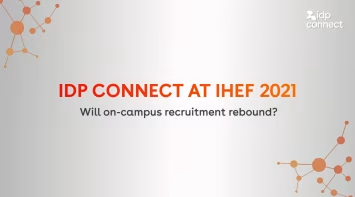Marissa Mayer, the former president and CEO of Yahoo, once remarked, “To me, the future is personalization.” Let’s face it…the future is here. Have you searched the web, or any shopping sites, for a future purchase only to see seconds, minutes, or hours later very specific ads for those same products pop up in your social media feeds and elsewhere online? If so, you can attest that we see what we search for in a variety of ways. For prospective international students and their parents, should it be any different? Let’s explore the ways our recruitment efforts can be personalized to deepen the connection future students feel toward our colleges and universities.

Image courtesy of the Amnet Group
Ask yourself: What would I want?
If you were an international student looking to study outside your home country, what would you want to see, hear, and read from colleges trying to recruit you? What would sound more personal to you: A “Dear Student” generic email blathering on about how great your college is, or one that acknowledges how significant the student’s interest in your institution actually is to you? Clearly the latter. These initial exchanges are about exploring a relationship between the student and your college. Remember what we said about having a global perspective? These students have many options in the United States and beyond. Students want to be liked, just like we do. Show it!
In developing a personalized approach, there are a variety of factors to consider as to how to target messages to your prospective student (and parent) audiences and what they may want to hear. In years gone by, much of this work was entirely manual in nature, as CRMs simply didn’t have the capacity to do much beyond first name and academic major, if you were lucky. Today, with a robust CRM, international prospects can be messaged in ways that respond to their interests in and outside the classroom, their country of residence, as well as particular concerns raised in email, social media posts, chats, virtual meetings, and more.
In this increasingly competitive global race to attract internationally mobile students, those college admissions officers that set themselves apart by going to extra lengths to establish personal relationships and demonstrate their concern will see the most success. In a recent article, the president of Franklin and Marshall College shared quite clearly how personal relationships matter when it comes to recruiting international students. Now more than ever, in the wake of the current pandemic, these relationships are critical to re-establishing and maintaining your authenticity.
Also, it needs to be said: for the love of all that is real, don’t take yourself or your institution so seriously. There’s a time and place for that, to be sure, but please don’t be afraid to use humor, as long as it’s culturally appropriate. We all need to be able to share a laugh now and then, even in the lofty towers of academia.
Provide multi-lingual content
Personalization can and should (given our industry) also mean having content, messages, subtitles, etc. available in the key languages of your college’s primary and even secondary markets. Having a variety of digital formats is key; the ability to repurpose this content to deliver it to your audiences in ways they prefer to receive it (e.g. email, pdfs, websites, microsites, social posts/video) is another important way to personalize your message.
A significant question related to having multi-lingual content is whether to produce it in-house or outsource. Both have positives and potential negatives. I presented at a NAFSA Conference in DC on this very topic back in 2019. The slide deck also has some important data from an IDP Connect student survey sharing the importance of having this kind of content available. It’s worth considering what IDP Connect’s International Content Hub can provide you, particularly if you don’t have the in-house resources to make it happen.
Develop key student personae
If you’re not familiar with the concept of student persona marketing, this approach can also offer a way to personalize your message to address issues or concerns common to certain types of students you might normally attract. There is certainly value in responding to general needs, especially in light of the pandemic. Review this useful piece from ICEF Monitor that shares successful examples of what institutions are leveraging lately.
If you’ve not read Dr. Rahul Choudaha’s research on his four core student personas– explorers, highfliers, strugglers, and strivers– which evaluates a student’s financial resources and academic preparedness measured on a low to high scale, it’s well worth your time. When we better understand the motivations of different personas, our ability to respond appropriately improves immeasurably.

Leverage storytelling
Lately, it has become clear that what works best in reaching prospective students are not the flashy (virtual) brochures, staged diversity pictures, or highly polished marketing videos, but rather the stories your current students can tell. Why? They can paint the picture of what life might be like. What will resonate most with future students in the midst of a pandemic? The answer is clearly found in what your enrolled students have to say.
If you identify international students, faculty, staff, and/or alumni who best represent the institutional values you want prospective audiences to connect with, let them tell their stories. Then you can leverage those gems across a wide range of platforms, languages, and formats to your key audiences.
Next month, we’ll take a deep dive into a related topic, the final P of this 6 Ps series, with a focus on peers.
You might like...

Why you should add retargeting to your digital marketing toolkit
Understand how retargeting could benefit your institution

Digital Marketing Case Study: The Boston Architectural College
Explore the results of a highly effective retargeting campaign with The Boston Architectural College

Content tips for institutions to engage with the Turkish student market
Snapshot interview with Esengul Kercin, Senior Country Marketing Executive for Hotcourses Turkey



